“The two largest lakes in Hungary are represented in this café. One half: Lake Balaton, the other half: Fertő! ” - the funny saying of the time was referring to the name of the Balaton Café and the two separate halves of the space. [Fertő is the name of another Hungarian lake, but it also means morass or slough] In one half of the popular café, there were frequent battles between the representatives of the big politics, in addition to well-known politicians, famous actors and famous writers had their desks here, while the other half was populated by gamblers, playing cards, surrounded by a bunch of kibitzers.
Under the former 17 Kerepesi Road (from 1906 17 Rákóczi Road), Schramek Vendéglő used to operate, where the Magyar Pincér Asztaltársaság [Hungarian Waiters' Table Company] was founded in 1890 with 40 members for the purpose of Hungarianizing the language of the catering sector and organizing charity. The four-storey tenement house, still standing today, was built in 1893 according to the plans of Péter Mayer, on behalf of the owner Kálmán Tafler. As one of the richest virilists in the capital, Tafler also played an important role in the General Assembly, and with his son-in-law, dr. Ármin Stern, a lawyer-composer-art collector and an expert in Dutch painting, owned nearly a hundred rental palaces in Budapest and Vienna.
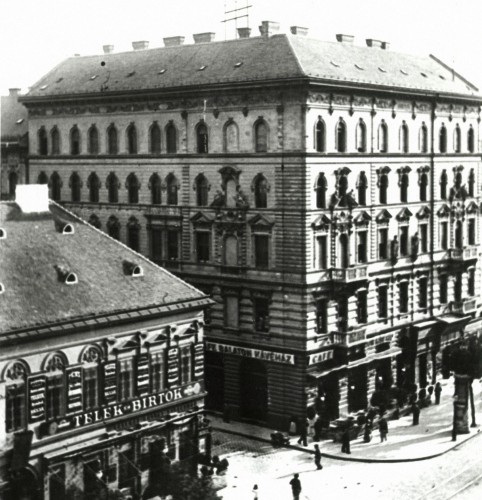
The tenement house, which still stands today and housed the former Balaton Café, was built in 1893 (Source: Hungarian Museum of Trade and Tourism PC: 184226)
József Tihanyi, the main waiter of the Weingruber restaurant, rented the ground floor of the tenement house from Kálmán Tafler, the owner of the house, thus starting his business. Balaton Café opened its doors to guests on 24 May 1894, at 12 noon. One of the goals was to surpass the luxury splendour of the New York Café, which opened in October of the same year. Standing on the other corner of Rákóczi Road and Szentkirályi Street, Mátyás király fogadó [King Matthias's inn] soon lost its significance in the competition with the modern Balaton Café.
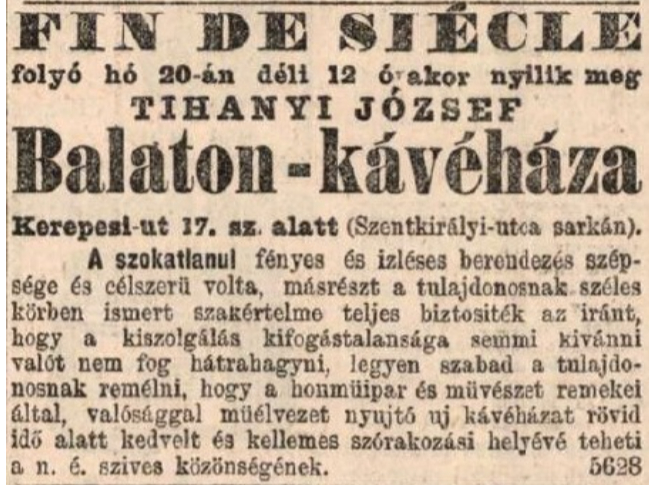
Press announcement of the opening of the Balaton Café (Source: Pesti Napló, 20 May 1894)
The interior of the Balaton Café was decorated with huge chandeliers, chimneys, mirrors, curtains, gobelins, rich gilding and wood carvings, artificial marble, columns and arches held by caryatids , and the huge cash register was covered with rayon drapery. Originally frescoes depicting life on Lake Balaton, the dubious artistic works of a certain Neumann title painter adorned the walls, which were later replaced by a colourful tile covering of the landscapes of Lake Balaton made by the Zsolnay factory.
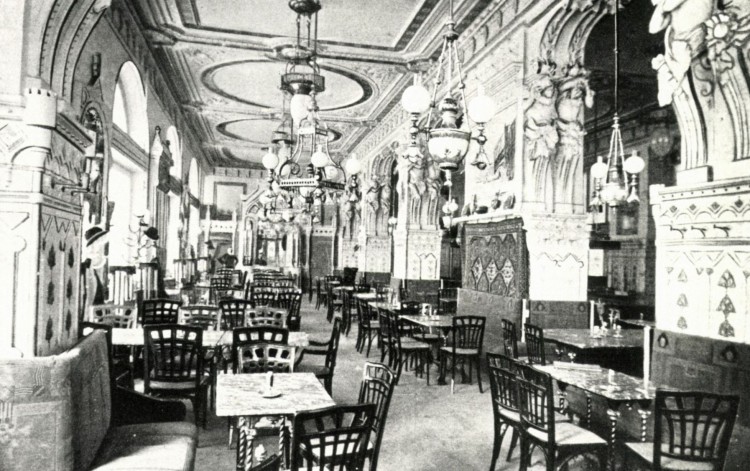
The interior of the Balaton Café. Photos from the collection of the Hungarian Museum of Trade and Tourism
The brightly decorated exclusive café soon became popular, especially among politicians, but also became the home of many journalists, actors, artists and writers. Mostly independence party politicians gathered here: Sándor Wekerle, the three-time prime minister, Ferenc Kossuth (son of Lajos Kossuth), János Hock and the young Mihály Károlyi. Journalists, one of the best known of them, Lajos Mikes, also took part in the debates as a public figure.
Artists also frequently visited here: János Vajda, Endre Ady, Gyula Krúdy, Ferenc Molnár, Géza Csáth, Frigyes Karinthy, Dezső Kosztolányi, Jenő Tersánszky Józsi , Zoltán Ambrus, Béla Paulini. Actors at the nearby National Theater also spent the night here many times after their performances.
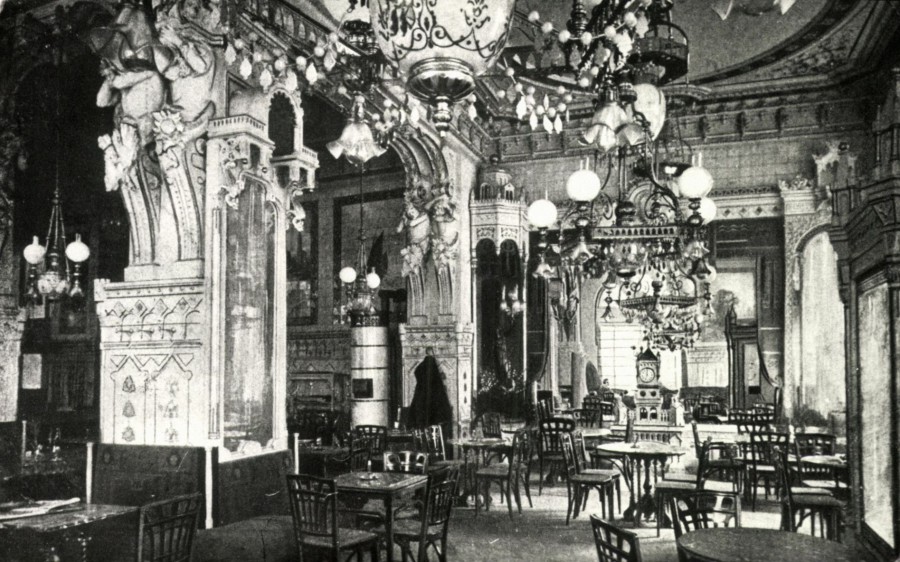
The Balaton Café has become the haunt of politicians, journalists and artists (Photo: Collection of the Hungarian Museum of Trade and Tourism)
“There was a time when the cauldrons of Hungary's domestic political witch kitchen were rattling in this room. Notable historical actions set out from here on their conquest journey. Palam et publice (in public, in front of everyone's eyes - Ed.) dictated the politicians at the main tables, accompanied by the usual approval, serenity, cheering, “movement and restlessness” - Pesti Hírlap recalled the heyday in its issue published on 4 April 1926.
Political debates usually ended before midnight, but the situation was completely different in the obstruction debate of 1904, during the passionate conciliation of politicians criticizing Prime Minister István Tisza. Writer Zoltán Ambrus, a journalist who usually started ceremonially reading newspapers at midnight and then writing, one night during the obstruction debate, turned to the audience of Balaton Café angrily: “Sorry, gentlemen, does it not bother you that I am reading a newspaper?”
.jpg)
The house at 17 Rákóczi Road today (Photo: László Bálint Nagy / pestbuda.hu)
"The forum of political life, the centre of the literary world and the meeting place of journalism has been the Balaton Café for almost a quarter of a century," Lajos Róna wrote in his book published in 1930. As he put it: "the Hungarian public was really made by the Balaton, the big political actions started there, careers flourished and people fell from the heights, governments were organized and overthrown, parties were disbanded and united, mandates and glory were distributed."
The artist of the Vígszínház, Sándor Góth, recalled his experiences with the card table of the café in the columns of the 21 December 1913 issue of Színházi Élet: “I spent many lovely hours with the Master, but I remember most gladly those times when I also played with Újházi. Yes, I played with him almost every blessed night for about two years. I was his partner and we also had a good number of viewers, especially politicians. Members of the famous political core table of the Balaton Café. Because we played there. In the Balaton. We played not theater, but Alsós [a Hungarian card game]. And in the huge wreath of homage for his art, let me also weave a laurel: the appreciation of the Alsós-partner. Because it has to be given, the Master played this well too. ”
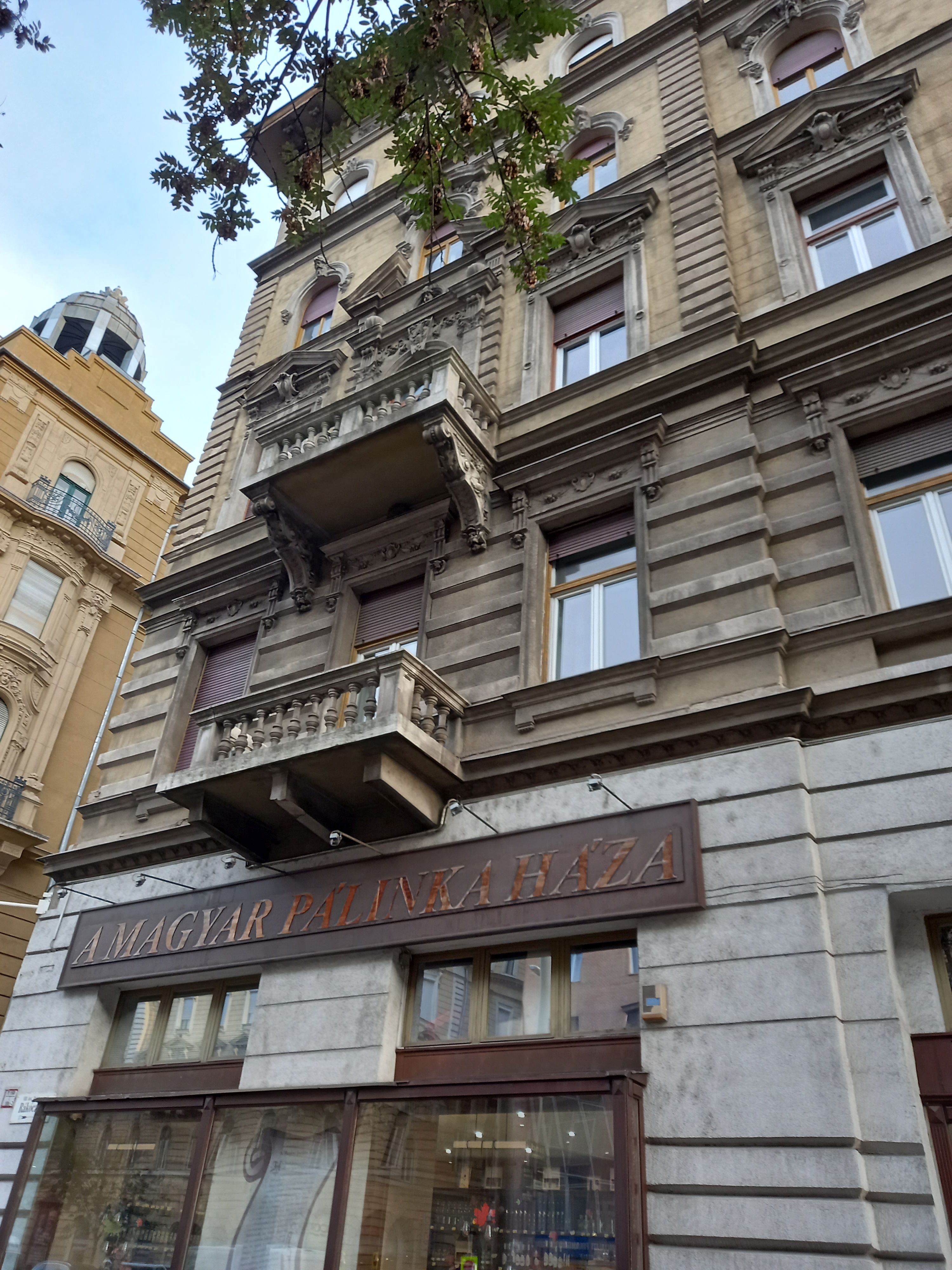
Part of the facade of the former café on Rákóczi Road today (Photo: László Bálint Nagy / pestbuda.hu)
Gyula Krúdy also commemorates the head of the café, József Tihanyi, in his novel A kékszalag hőse [The Hero of the Blue Ribbon], true that he perpetuated the Balaton Café as Tihany Café (with its clearly identifiable characteristics), and József Tihanyi is shown as Mr. Balatoni: "In the Tihany Café, however it was before noon, Regényi entered as calmly as if he had turned around the revolving door for the last time just yesterday, with which Mr. Balaton, the owner of the Tihany Café, wanted to make his business in the capital famous and modern, ”says Krúdy.
The son of József Tihanyi, who created an oeuvre in the catering industry, was painter Lajos Tihanyi, a member of the Eight. In addition to the artist who deafened in his youth, the café owner had three daughters, Erzsébet, Matild and Stefánia, and another son, Ernő, who continued his business and worked as a lawyer. Ownership later passed to the children of Kálmán Tafler, including Kornelia Tafler, who separated from Ármin Stern, and married a Viennese conductor, Rudolf Nilius, 17 years younger than him.
During the years of the global economic crisis and inflation, Kornélia Tafler and her brothers deprived dr. Ernő Tihanyi of the right to rent, citing the arrears. Finally, with the help of creditors, the Tihanyi family was able to continue the business, in the 1935 company registration under the name Rákóczi úti Étterem és Kávéház Kft. [Rákóczi Road Restaurant and Café Ltd.], under the management of Enikő Lőwy, and from 1939 under the management of Gyula Pelzmann. At that time, the leaders of the Smallholders' Party, led by Tibor Eckhardt, established their headquarters here. Surviving the Holocaust, in 1946 dr. Ernő Tihanyi became the managing director. He could not run the café for long, as it was permanently closed in 1949 at the time of nationalization.
.jpg)
The facade of Szentkirályi Street today, on the ground floor, in the former hall of the Balaton Café, the examination center of ELTE was established (Photo: László Bálint Nagy / pestbuda.hu)
The examination center of the Faculty of Economics of Eötvös Loránd University was opened on 4 October this year on the Szentkirályi Street side of the ground floor of the house at Rákóczi Road 17. The room, which can accommodate about 200 people and hold 10,000 exams a week, awaits students in a simple interior with modern equipment. In the street corner of the former café, the Hungarian Pálinka House has been offering Hungarian spirits since 2003. There is no trace of the former, luxuriously designed Balaton Café.
Cover photo: The interior of the Balaton Café (Source: Hungarian Museum of Trade and Tourism)

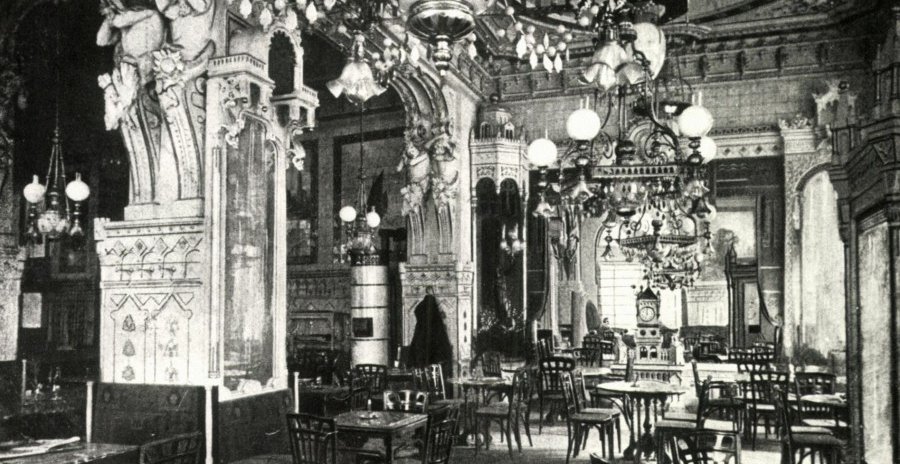


































Hozzászólások
Log in or register to comment!
Login Registration